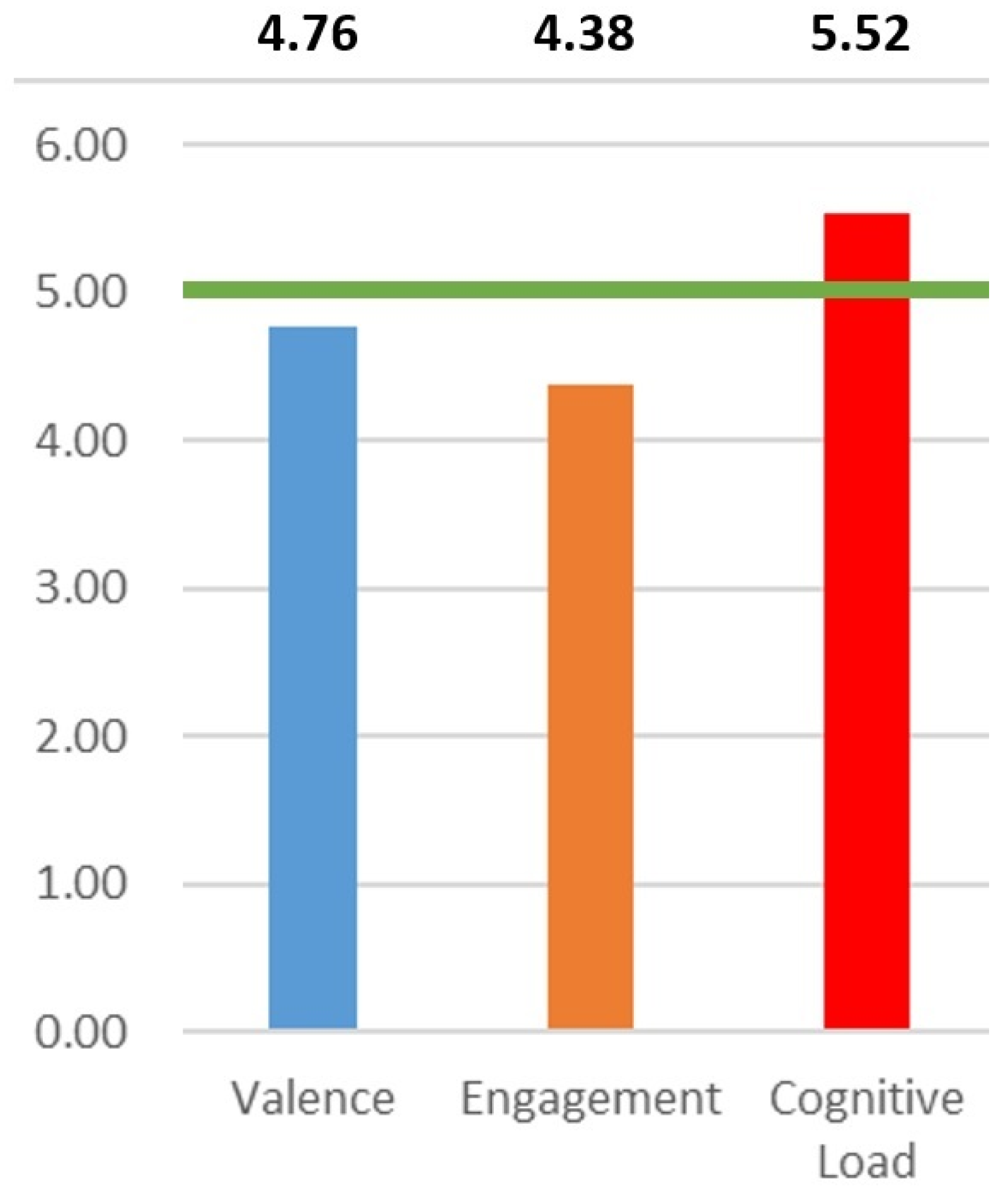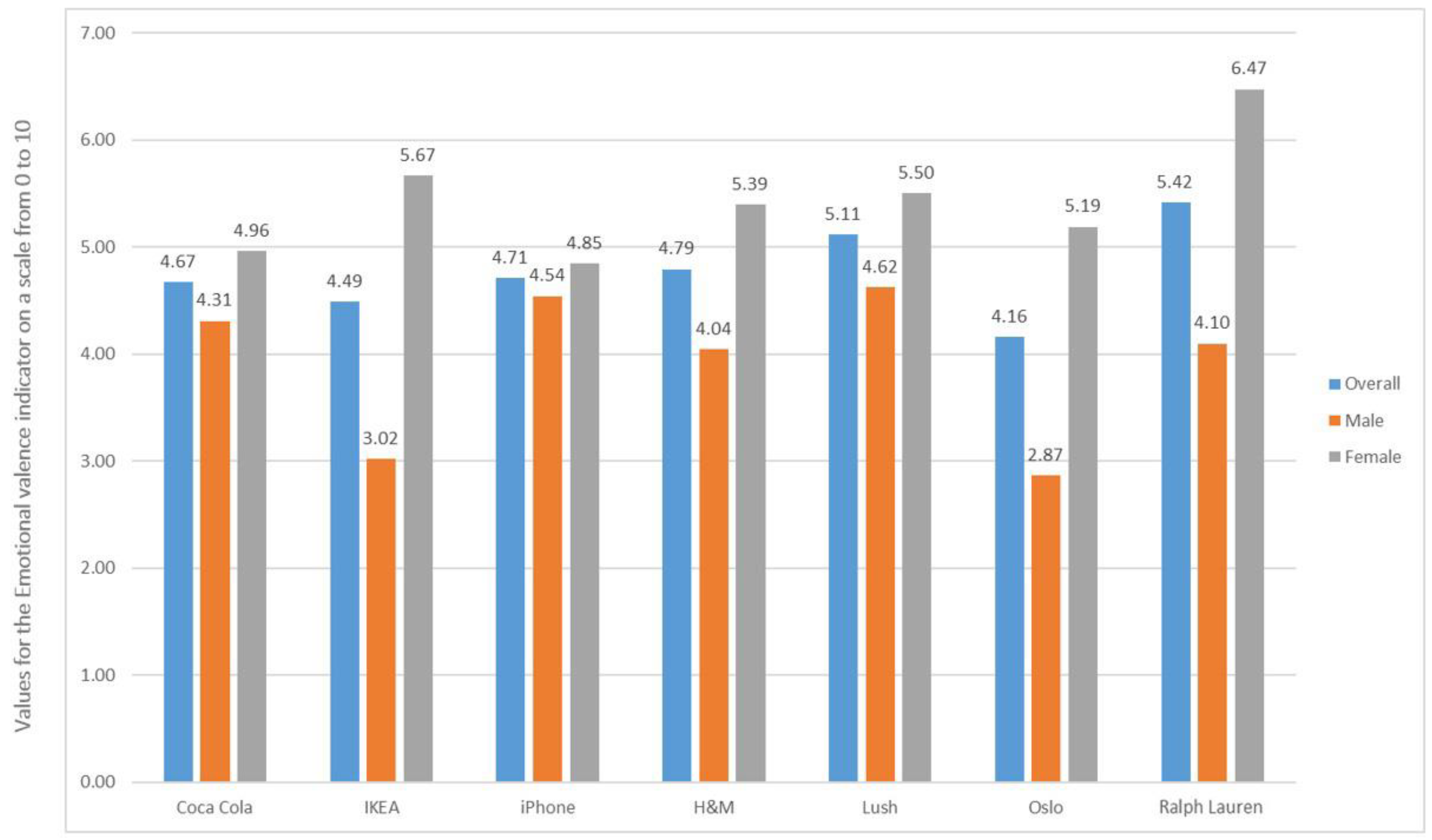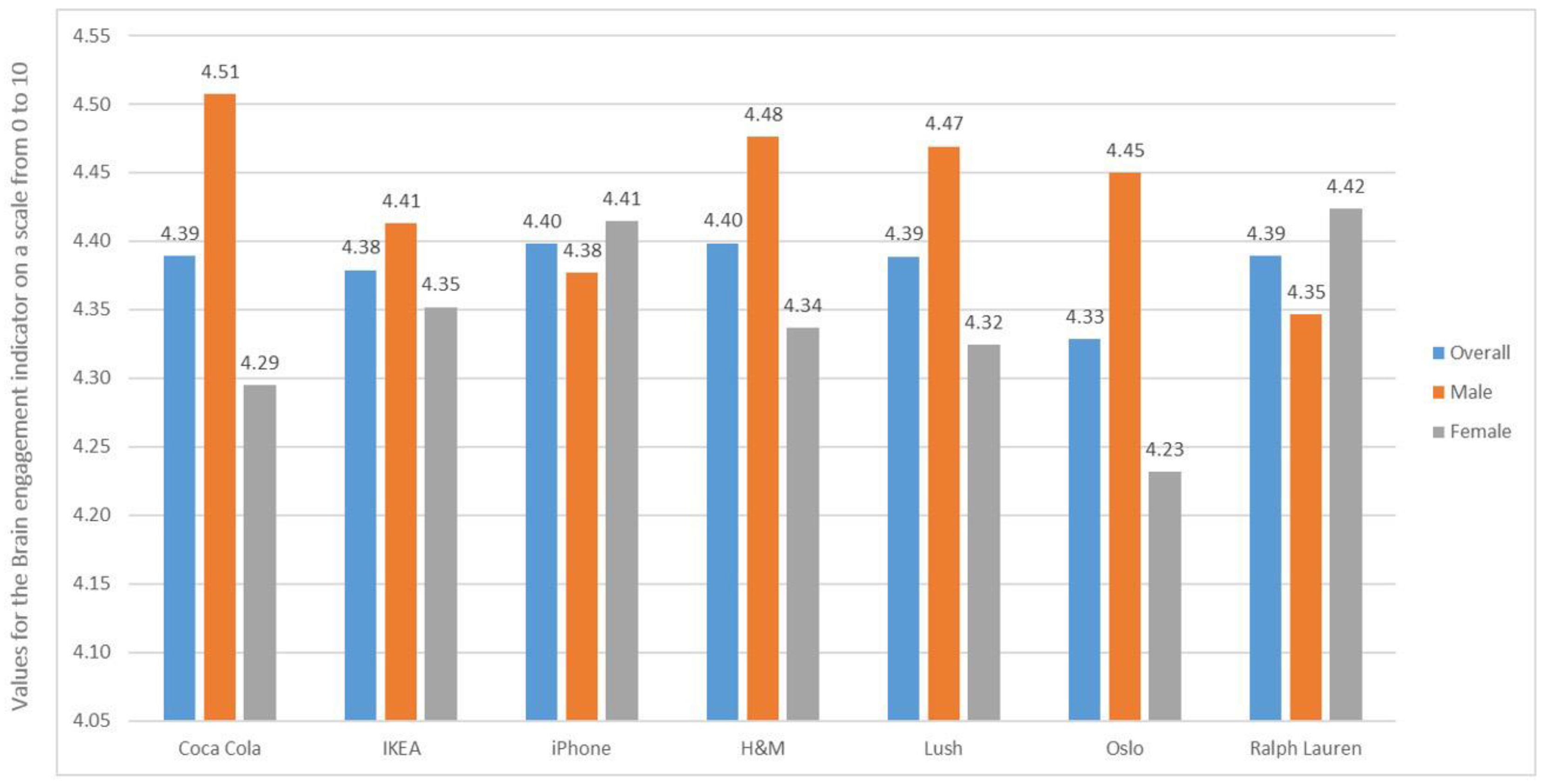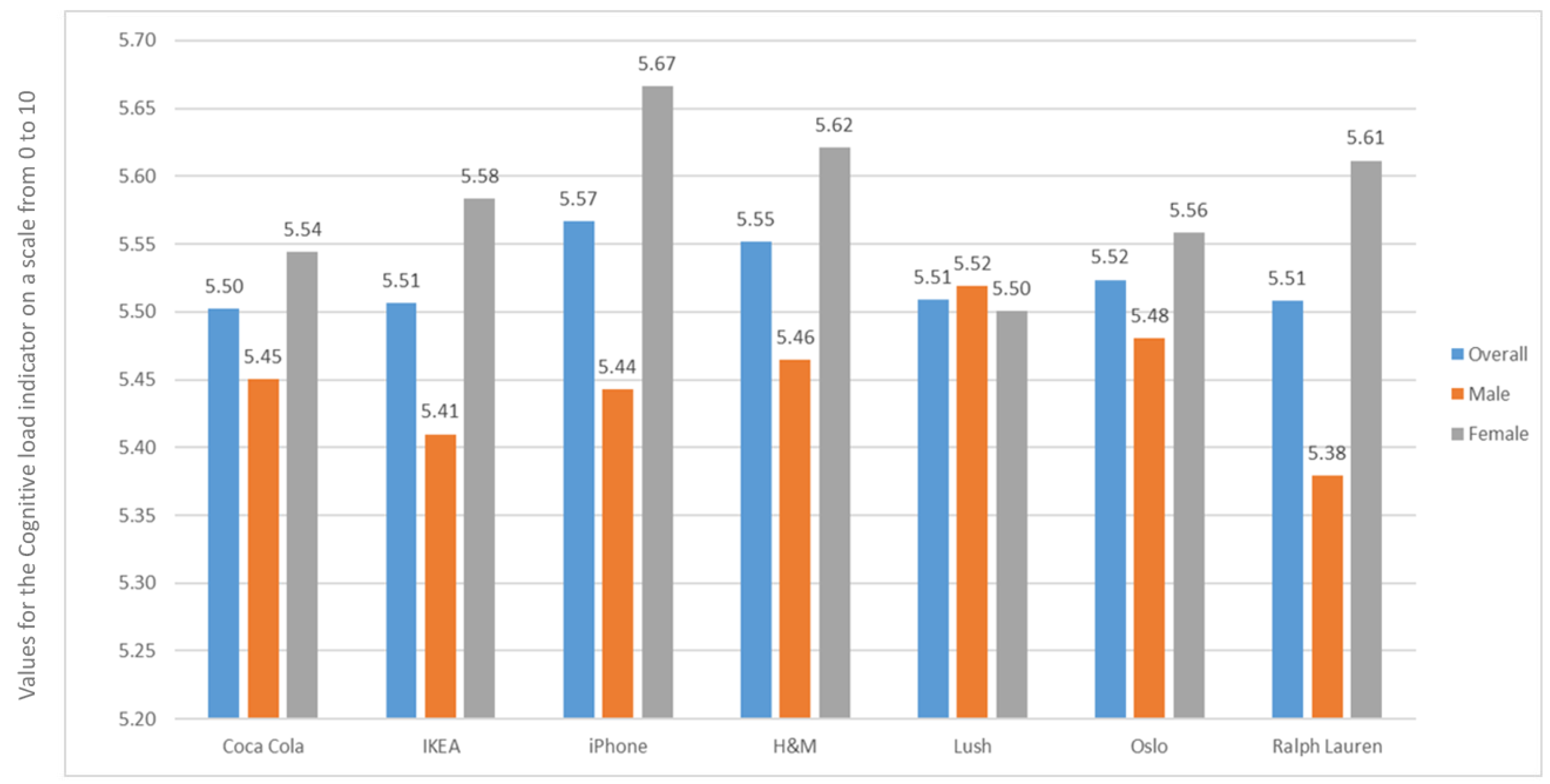Neuroscience and CSR: Using EEG for Assessing the Effectiveness of Branded Videos Related to Environmental Issues
Abstract
:1. Introduction
- RP. To examine the effectiveness of CSR communications, and especially of branded videos of environmental issues, by utilising neuroscientific methods vs. traditional methods.
- Q1. To what extent do brains implicitly find CSR communications appealing?
- Q2. To what extent do brains implicitly engage with CSR communications?
- Q3. To what extent do brains implicitly process CSR communications?
- Q4. To what extent do these results differ between genders?
- Q5. To what extent do the implicit results differ from the explicit responses?
2. Background and Context
3. Materials and Methods
3.1. Study Scope
3.2. Metrics Meaning and Interpretation
3.2.1. Emotional Valence
3.2.2. Level of Brain Engagement
3.2.3. Cognitive Load
3.2.4. EEG Calibration and Data Presentation
4. Results
4.1. Overall Results
4.2. Results by Gender—Are There Any Differences?
4.3. Comparison of Self-Reporting Results to Neuro Results
5. Discussion
6. Conclusions
Author Contributions
Funding
Institutional Review Board Statement
Informed Consent Statement
Data Availability Statement
Conflicts of Interest
Appendix A
- Video A1: COCA-COLA, available online at https://www.youtube.com/watch?v=MD6ORHLbaAA, accessed on 15 June 2020;
- Video A2: IKEA, available online at https://www.youtube.com/watch?v=NqFQ3aquBsY, accessed on 15 June 2020;
- Video A3: APPLE, available online at https://www.youtube.com/watch?v=BojVVZod8qo, accessed on 15 June 2020;
- Video A4: H&M, available online at https://www.youtube.com/watch?v=7i4JSzB8VlU, accessed on 15 June 2020;
- Video A5: LUSH COSMETICS, available online at https://www.youtube.com/watch?v=cxDgMktHPfo, accessed on 15 June 2020;
- Video A6: OSLO, available online at https://www.youtube.com/watch?v=M2G_hvIrrKk, accessed on 15 June 2020;
- Video A7: RALPH LAUREN available online https://www.youtube.com/watch?v=sK_8898E2VY, accessed on 15 June 2020.
References
- Ferreira, I.; Van Der Horst, K.; Wendel-Vos, W.; Kremers, S.; Van Lenthe, F.J.; Brug, J. Environmental correlates of physical activity in youth—A review and update. Obes. Rev. 2007, 8, 129–154. [Google Scholar] [CrossRef] [PubMed]
- Arnold, H.E.; Cohen, F.G.; Warner, A. Youth and Environmental Action: Perspectives of Young Environmental Leaders on Their Formative Influences. J. Environ. Educ. 2009, 40, 27–36. [Google Scholar] [CrossRef]
- Schusler, T.M.; Krasny, M.E. Environmental Action as Context for Youth Development. J. Environ. Educ. 2010, 41, 208–223. [Google Scholar] [CrossRef]
- Priesemann, V.; Brinkmann, M.M.; Ciesek, S.; Cuschieri, S.; Czypionka, T.; Giordano, G.; Gurdasani, D.; Hanson, C.; Hens, N.; Iftekhar, E.; et al. Calling for pan-European commitment for rapid and sustained reduction in SARS-CoV-2 infections. Lancet 2021, 397, 92–93. [Google Scholar] [CrossRef]
- Zhao, J. Reimagining Corporate Social Responsibility in the Era of COVID-19: Embedding Resilience and Promoting Corporate Social Competence. Sustainability 2021, 13, 6548. [Google Scholar] [CrossRef]
- Leonard, H.J.; Leonard, H.J.L. Pollution and the Struggle for the World Product: Multinational Corporations, Environment, and International Comparative Advantage; Cambridge University Press: Cambridge, UK, 1988. [Google Scholar]
- Stern, P.C. Understanding individuals’ environmentally significant behavior. Environ. Law Rep. News Anal. 2005, 35, 10785. [Google Scholar]
- Jenkins, H. Small Business Champions for Corporate Social Responsibility. J. Bus. Ethics 2006, 67, 241–256. [Google Scholar] [CrossRef]
- Popescu, G.H. The role of multinational corporations in global environmental politics. Econ. Manag. Financ. Mark. 2016, 11, 72–78. [Google Scholar]
- Ćirović, M.; Petrović, N.; Milenković, N. Environmental Awareness and Causal Behavioural Patterns—Why Do We Make “Wrong” Environmental Choices? In Proceedings of the 38. Mednarodna Konferenca O Razvoju Organizacijskih Znanosti, Portorož, Slovenija, 20 March 2019; p. 177. [Google Scholar]
- Van Neuss, L. The drivers of structural change. J. Econ. Surv. 2019, 33, 309–349. [Google Scholar] [CrossRef]
- Botero, C.A.; Weissing, F.J.; Wright, J.; Rubenstein, D.R. Evolutionary tipping points in the capacity to adapt to environmental change. Proc. Natl. Acad. Sci. USA 2015, 112, 184–189. [Google Scholar] [CrossRef] [Green Version]
- Rockström, J.; Steffen, W.; Noone, K.; Persson, Å.; Chapin, F.S., III; Lambin, E.; Foley, J.; Folke, C.; Schellnhuber, H.J.; Nykvist, B.; et al. Planetary boundaries: Exploring the safe operating space for humanity. Ecol. Soc. 2009, 14, 1–33. [Google Scholar] [CrossRef]
- Steffen, W.; Richardson, K.; Rockström, J.; Cornell, S.E.; Fetzer, I.; Bennett, E.M.; Sörlin, S. Planetary boundaries: Guiding human development on a changing planet. Science 2015, 347, 1259855. [Google Scholar] [CrossRef] [PubMed] [Green Version]
- Burgess, J.; Harrison, C.M.; Filius, P. Environmental Communication and the Cultural Politics of Environmental Citizenship. Environ. Plan. A Econ. Space 1998, 30, 1445–1460. [Google Scholar] [CrossRef] [Green Version]
- Diedring, K. Framing Environmental Messages: Examining Audience Response to Humor, Shock, and Emotional Treatments. Ph.D. Thesis, University of South Florida, Tampa, FL, USA, 2008. [Google Scholar]
- Bertolotti, M.; Catellani, P. Going Green, but Staying in the Black: How Framing Impacts the Agreement with Messages on the Economic Consequences of Environmental Policies. Front. Psychol. 2021, 12, 1192. [Google Scholar] [CrossRef] [PubMed]
- Yin, C.; Zhang, Y.; Lu, L. Employee-Oriented CSR and Unethical Pro-Organizational Behavior: The Role of Perceived Insider Status and Ethical Climate Rules. Sustainability 2021, 13, 6613. [Google Scholar] [CrossRef]
- Shrivastava, P. The role of corporations in achieving ecological sustainability. Acad. Manag. Rev. 1995, 20, 936–960. [Google Scholar] [CrossRef]
- Rogers, K.S. Ecological security and multinational corporations. Environ. Chang. Secur. Proj. Rep. 1997, 3, 29–36. [Google Scholar]
- Simmons, C. Will you be on our board of directors? We need help: Media corporations, environmental change, and resource dependency theory. J. Mass Commun. Q. 2012, 89, 55–72. [Google Scholar] [CrossRef]
- Lewin, L.D.; Warren, D.E.; Alsuwaidi, M. Does CSR make better citizens? The influence of employee CSR programs on employee societal citizenship behavior outside of work. Bus. Soc. Rev. 2020, 125, 271–288. [Google Scholar] [CrossRef]
- Sen, S.; Bhattacharya, C. Does Doing Good Always Lead to Doing Better? Consumer Reactions to Corporate Social Responsibility. J. Mark. Res. 2001, 38, 225–243. [Google Scholar] [CrossRef]
- Newell, P.; Frynas, J.G. Beyondcsr? Business, poverty and social justice: An introduction. Third World Q. 2007, 28, 669–681. [Google Scholar] [CrossRef]
- Bowen, H.R. Social Responsibilities of the Businessman; University of Iowa Press: Iowa City, IA, USA, 2013. [Google Scholar]
- Kotler, P.; Lee, N. Best of Breed: When it Comes to Gaining a Market Edge While Supporting a Social Cause, “Corporate Social Marketing” Leads the Pack. Soc. Mark. Q. 2005, 11, 91–103. [Google Scholar] [CrossRef]
- Sheehy, B. Defining CSR: Problems and Solutions. J. Bus. Ethics 2015, 131, 625–648. [Google Scholar] [CrossRef]
- Borelli, C. The Commitment to Art as a Corporate Strategic Decision. Master’s Thesis, Double Degree, LUISS Guido Carli University, Rome, Italy, Italy and Paris Dauphine University, Paris, France, 2019. [Google Scholar]
- Sánchez-Teba, E.M.; Benítez-Márquez, M.D.; Bermúdez-González, G.; Luna-Pereira, M.D.M. Mapping the Knowledge of CSR and Sustainability. Sustainability 2021, 13, 10106. [Google Scholar] [CrossRef]
- Carroll, A.B. The pyramid of corporate social responsibility: Toward the moral management of organizational stakeholders. Bus. Horiz. 1991, 34, 39–48. [Google Scholar] [CrossRef]
- Kotler, P.; Lee, N. Corporate Social Responsibility: Doing the Most Good for Your Company and Your Cause; John Wiley & Sons: New York, NY, USA, 2008. [Google Scholar]
- Wu, Q.; Cherian, J.; Samad, S.; Comite, U.; Hu, H.; Gunnlaugsson, S.B.; Oláh, J.; Sial, M.S. The Role of CSR and Ethical Leadership to Shape Employees’ Pro-Environmental Behavior in the Era of Industry 4.0. A Case of the Banking Sector. Sustainability 2021, 13, 9773. [Google Scholar] [CrossRef]
- Sheehy, B. Understanding CSR: An empirical study of private regulation. Monash Univ. Law Rev. 2012, 38, 103–127. [Google Scholar]
- Zaltman, G. How Customers Think: Essential Insights into the Mind of the Market; Harvard Business Press: Boston, MA, USA, 2003. [Google Scholar]
- Nease, B. The Power of Fifty Bits: The New Science of Turning Good Intentions into Positive Results; HarperCollins: New York, NY, USA, 2016. [Google Scholar]
- Koenig-Robert, R.; Pearson, J. Decoding the contents and strength of imagery before volitional engagement. Sci. Rep. 2019, 9, 3504. [Google Scholar] [CrossRef]
- Lin, M.H.J.; Cross, S.N.; Jones, W.J.; Childers, T.L. Applying EEG in consumer neuroscience. Eur. J. Mark. 2018, 52, 66–91. [Google Scholar] [CrossRef]
- Barnett, S.B.; Cerf, M. A ticket for your thoughts: Method for predicting content recall and sales using neural similarity of moviegoers. J. Consum. Res. 2017, 44, 160–181. [Google Scholar]
- Hazlett, R.L.; Hazlett, S.Y. Emotional response to television commercials: Facial EMG vs. self-report. J. Advert. Res. 1999, 39, 7–23. [Google Scholar]
- Meier, S.; Cassar, L. Stop talking about how CSR helps your bottom line. Harv. Bus. Rev. 2018, 31, 1–6. [Google Scholar]
- Hopkins, M. CSR and international development. In CSR and Sustainability; Routledge: London, UK, 2017; pp. 60–79. [Google Scholar]
- Chae, M.-J. Driving Consumer Engagement through Diverse Calls to Action in Corporate Social Responsibility Messages on Social Media. Sustainability 2021, 13, 3812. [Google Scholar] [CrossRef]
- Dimock, M. Defining generations: Where Millennials end and Generation Z begins. Pew Res. Cent. 2019, 17, 1–7. [Google Scholar]
- Telpaz, A.; Webb, R.; Levy, D.J. Using EEG to Predict Consumers’ Future Choices. J. Mark. Res. 2015, 52, 511–529. [Google Scholar] [CrossRef] [Green Version]
- Gordon, R.; Ciorciari, J.; Van Laer, T. Using EEG to examine the role of attention, working memory, emotion, and imagination in narrative transportation. Eur. J. Mark. 2018, 52, 92–117. [Google Scholar] [CrossRef] [Green Version]
- Khushaba, R.N.; Wise, C.; Kodagoda, S.; Louviere, J.; Kahn, B.E.; Townsend, C. Consumer neuroscience: Assessing the brain response to marketing stimuli using electroencephalogram (EEG) and eye tracking. Expert Syst. Appl. 2013, 40, 3803–3812. [Google Scholar] [CrossRef]
- Bazzani, A.; Ravaioli, S.; Trieste, L.; Faraguna, U.; Turchetti, G. Is EEG Suitable for Marketing Research? A Systematic Review. Front. Neurosci. 2020, 14, 1343. [Google Scholar] [CrossRef]
- Kulke, L.; Feyerabend, D.; Schacht, A. A Comparison of the Affectiva iMotions Facial Expression Analysis Software with EMG for Identifying Facial Expressions of Emotion. Front. Psychol. 2020, 11, 329. [Google Scholar] [CrossRef]
- Berggren, N.; Koster, E.; Derakhshan, N. The effect of cognitive load in emotional attention and trait anxiety: An eye movement study. J. Cogn. Psychol. 2012, 24, 79–91. [Google Scholar] [CrossRef] [Green Version]
- Chen, S.; Epps, J. Automatic classification of eye activity for cognitive load measurement with emotion interference. Comput. Methods Programs Biomed. 2013, 110, 111–124. [Google Scholar] [CrossRef] [PubMed]
- Lambert, S.; Dimitriadis, N.; Taylor, M.; Venerucci, M. Understanding emotional empathy at postgraduate business programmes: What does the use of EEG reveal for future leaders? High. Educ. Ski. Work-Based Learn. 2021, 11, 1180–1191. [Google Scholar] [CrossRef]
- Demaree, H.; Everhart, D.; Youngstrom, E.; Harrison, D.W. Brain Lateralization of Emotional Processing: Historical Roots and a Future Incorporating “Dominance”. Behav. Cogn. Neurosci. Rev. 2005, 4, 3–20. [Google Scholar] [CrossRef] [PubMed] [Green Version]
- Davidson, R.J.; Fox, N.A. Asymmetrical Brain Activity Discriminates Between Positive and Negative Affective Stimuli in Human Infants. Science 1982, 218, 1235–1237. [Google Scholar] [CrossRef] [PubMed]
- Palmiero, M.; Piccardi, L. Frontal EEG Asymmetry of Mood: A Mini-Review. Front. Behav. Neurosci. 2017, 11, 224. [Google Scholar] [CrossRef]
- Sikka, P.; Revonsuo, A.; Noreika, V.; Valli, K. EEG Frontal Alpha Asymmetry and Dream Affect: Alpha Oscillations over the Right Frontal Cortex during REM Sleep and Presleep Wakefulness Predict Anger in REM Sleep Dreams. J. Neurosci. 2019, 39, 4775–4784. [Google Scholar] [CrossRef]
- Dimitriadis, N.; Psychogios, A. Neuroscience for Leaders: Practical Insights to Successfully Lead People and Organizations; Kogan Page Publishers: London, UK, 2020. [Google Scholar]
- Hutchinson, J.B.; Barrett, L.F. The Power of Predictions: An Emerging Paradigm for Psychological Research. Curr. Dir. Psychol. Sci. 2019, 28, 280–291. [Google Scholar] [CrossRef]
- McMahan, T.; Parberry, I.; Parsons, T.D. Evaluating Player Task Engagement and Arousal Using Electroencephalography. Procedia Manuf. 2015, 3, 2303–2310. [Google Scholar] [CrossRef] [Green Version]
- Berka, C.; Levendowski, D.J.; Lumicao, M.N.; Yau, A.; Davis, G.; Zivkovic, V.T.; Olmstead, R.E.; Tremoulet, P.D.; Craven, P.L. EEG correlates of task engagement and mental workload in vigilance, learning, and memory tasks. Aviat. Space Environ. Med. 2007, 78, B231–B244. [Google Scholar]
- Kalyuga, S. Knowledge elaboration: A cognitive load perspective. Learn. Instr. 2009, 19, 402–410. [Google Scholar] [CrossRef] [Green Version]
- Haapalainen, E.; Kim, S.; Forlizzi, J.F.; Dey, A.K. Psycho-physiological measures for assessing cognitive load. In Proceedings of the 12th ACM International Conference on Ubiquitous Computing, Copenhagen, Denmark, 26–29 September 2010; pp. 301–310. [Google Scholar]
- Sweller, J.; Ayres, P.; Kalyuga, S. Measuring Cognitive Load. In Cognitive Load Theory; Explorations in the Learning Sciences, Instructional Systems and Performance Technologies; Springer: New York, NY, USA, 2011; Volume 1. [Google Scholar] [CrossRef] [Green Version]
- Nuamah, J.; Seong, Y.; Yi, S. Electroencephalography (EEG) classification of cognitive tasks based on task engagement index. In Proceedings of the 2017 IEEE Conference on Cognitive and Computational Aspects of Situation Management (CogSIMA), Savannah, GA, USA, 27–31 March 2017; pp. 1–6. [Google Scholar]
- Antonenko, P.; Paas, F.; Grabner, R.; Van Gog, T. Using Electroencephalography to Measure Cognitive Load. Educ. Psychol. Rev. 2010, 22, 425–438. [Google Scholar] [CrossRef]
- De Jong, T. Cognitive load theory, educational research, and instructional design: Some food for thought. Instr. Sci. 2010, 38, 105–134. [Google Scholar] [CrossRef] [Green Version]
- He, H.; Wu, D. Channel and Trials Selection for Reducing Covariate Shift in EEG-based Brain-Computer Interfaces. In Proceedings of the 2019 IEEE International Conference on Systems, Man and Cybernetics (SMC), Bari, Italy, 6–9 October 2019; pp. 3635–3640. [Google Scholar]
- Tokar, B. Earth for Sale: Reclaiming Ecology in the Age of Corporate Greenwash; South End Press: Boston, MA, USA, 1997. [Google Scholar]
- Buchholz, R.A. Corporate responsibility and the good society: From economics to ecology. Bus. Horiz. 1991, 34, 19–31. [Google Scholar] [CrossRef]
- Haq, G.; Cambridge, H.; Owen, A. A targeted social marketing approach for community pro-environmental behavioural change. Local Environ. 2013, 18, 1134–1152. [Google Scholar] [CrossRef]
- Kurtycz, A. Understanding environmental behavioural change through communication: A new perspective of environmental education. Int. J. Environ. Sustain. Dev. 2005, 4, 35. [Google Scholar] [CrossRef]
- Skard, S.; Thorbjørnsen, H. Is Publicity Always Better than Advertising? The Role of Brand Reputation in Communicating Corporate Social Responsibility. J. Bus. Ethics 2014, 124, 149–160. [Google Scholar] [CrossRef] [Green Version]
- Kao, T.-F.; Tu, J.-C. Research on Corporate Social Responsibility Advertising Design. In Sustainability through Innovation in Product Life Cycle Design; Springer: Singapore, 2017; Volume 2, pp. 367–381. [Google Scholar]
- Matsumoto, S. The Opportunity Cost of Pro-Environmental Activities: Spending Time to Promote the Environment. J. Fam. Econ. Issues 2013, 35, 119–130. [Google Scholar] [CrossRef]
- Ruether, R.R. New Woman, New Earth: Sexist Ideologies and Human Liberation; Seabury Press: New York, NY, USA, 1975; p. 11336. [Google Scholar]
- Griffin, S. Woman and Nature: The Roaring inside Her; The Women’s Press: London, UK, 1978. [Google Scholar]
- Merchant, C. Earthcare: Women and the Environment. Environ. Sci. Policy Sustain. Dev. 1981, 23, 6–40. [Google Scholar] [CrossRef]
- Plumwood, V. Feminism and the Mastery of Nature; Routledge: London, UK, 2002. [Google Scholar]
- Mellor, M. Ecofeminism: Linking Gender and Ecology. In The SAGE Handbook of Environment and Society; SAGE Publications Ltd.: London, UK, 2007; pp. 66–77. [Google Scholar]
- Odrowaz-Coates, A. Definitions of Sustainability in the Context of Gender. Sustainability 2021, 13, 6862. [Google Scholar] [CrossRef]
- McCright, A.M.; Dunlap, R.E. Bringing ideology in: The conservative white male effect on worry about environmental problems in the USA. J. Risk Res. 2013, 16, 211–226. [Google Scholar] [CrossRef]
- Böcker, K.; Baas, J.; Kenemans, J.; Verbaten, M. Stimulus-preceding negativity induced by fear: A manifestation of affective anticipation. Int. J. Psychophysiol. 2001, 43, 77–90. [Google Scholar] [CrossRef]
- Hamann, S.; Herman, R.A.; Nolan, C.L.; Wallen, K. Men and women differ in amygdala response to visual sexual stimuli. Nat. Neurosci. 2004, 7, 411–416. [Google Scholar] [CrossRef] [PubMed]
- Kerkhoven, A.H.; Russo, P.; Land-Zandstra, A.; Saxena, A.; Rodenburg, F.J. Gender Stereotypes in Science Education Resources: A Visual Content Analysis. PLoS ONE 2016, 11, e0165037. [Google Scholar] [CrossRef] [PubMed]
- Verma, S. Do Consumers Respond Differently to Advertising Stimuli: An Empirical Study. South Asian J. Manag. 2009, 16, 71–85. [Google Scholar]
- Crewe, L.; Wang, A. Gender inequalities in the City of London advertising industry. Environ. Plan. A Econ. Space 2018, 50, 671–688. [Google Scholar] [CrossRef] [Green Version]
- Ragland, J.; Coleman, A.; Gur, R.C.; Glahn, D.C.; Gur, R.E. Sex differences in brain-behavior relationships between verbal episodic memory and resting regional cerebral blood flow. Neuropsychologia 2000, 38, 451–461. [Google Scholar] [CrossRef] [Green Version]
- Cox, T.A. How Corporate Social Responsibility Influences Buying Decisions; Cllutch: Washington, DC, USA, 2019. [Google Scholar]





| Self-Reporting Ranking | Self-Reporting Scores | Neuro Ranking | Neuro Scores |
|---|---|---|---|
| 1. H&M 2. LUSH 3. Coca-Cola 4. IKEA 5. iPhone 6. Oslo 7. RL | 8.74 8.30 7.04 6.96 6.44 6.00 5.92 | 1. RL 2. LUSH 3. iPhone 4. Coca-Cola 5. H&M 6. IKEA 7. Oslo | >5 >5 4.5–5 4.5–5 4.5–5 <4.5 <4.5 |
Publisher’s Note: MDPI stays neutral with regard to jurisdictional claims in published maps and institutional affiliations. |
© 2022 by the authors. Licensee MDPI, Basel, Switzerland. This article is an open access article distributed under the terms and conditions of the Creative Commons Attribution (CC BY) license (https://creativecommons.org/licenses/by/4.0/).
Share and Cite
Janić, M.; Ćirović, M.; Dimitriadis, N.; Jovanović Dimitriadis, N.; Alevizou, P. Neuroscience and CSR: Using EEG for Assessing the Effectiveness of Branded Videos Related to Environmental Issues. Sustainability 2022, 14, 1347. https://doi.org/10.3390/su14031347
Janić M, Ćirović M, Dimitriadis N, Jovanović Dimitriadis N, Alevizou P. Neuroscience and CSR: Using EEG for Assessing the Effectiveness of Branded Videos Related to Environmental Issues. Sustainability. 2022; 14(3):1347. https://doi.org/10.3390/su14031347
Chicago/Turabian StyleJanić, Milan, Marko Ćirović, Nikolaos Dimitriadis, Neda Jovanović Dimitriadis, and Panayiota Alevizou. 2022. "Neuroscience and CSR: Using EEG for Assessing the Effectiveness of Branded Videos Related to Environmental Issues" Sustainability 14, no. 3: 1347. https://doi.org/10.3390/su14031347
APA StyleJanić, M., Ćirović, M., Dimitriadis, N., Jovanović Dimitriadis, N., & Alevizou, P. (2022). Neuroscience and CSR: Using EEG for Assessing the Effectiveness of Branded Videos Related to Environmental Issues. Sustainability, 14(3), 1347. https://doi.org/10.3390/su14031347






